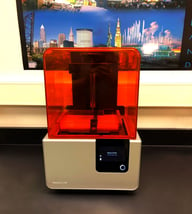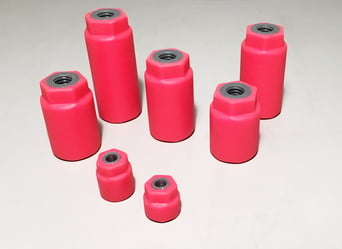 Advances in 3D printing have allowed its use to span across multiple industries including composites. Always striving to be at the forefront of technology, Mar-Bal has also implemented 3D printing at our R&D Center. Our 3D printer is a resin based printer which utilizes a tray of resin with a laser light that cures the resin in layers to build the model as it is lifted out of the resin tank.
Advances in 3D printing have allowed its use to span across multiple industries including composites. Always striving to be at the forefront of technology, Mar-Bal has also implemented 3D printing at our R&D Center. Our 3D printer is a resin based printer which utilizes a tray of resin with a laser light that cures the resin in layers to build the model as it is lifted out of the resin tank.
By having the technology of the 3D printer, we are able to produce a representation of the parts that are to be molded, and see if we need to make any further considerations to a tool build that could cost time and money if not discovered until production began. Additionally, 3D printing helps with design because it allows for an in hand part that can physically be held and observed in ways that might not be as visible when looking at a 3D model on a screen or a 2D drawing.
The inclusion of a 3D printer has added a new level of versatility to Mar-Bal's R&D Center. “A major benefit of having the 3D printer is that we can produce samples of products for customers to see as well as proprietary products for internal discussion. Not to mention that it is far more cost and time effective than building a tool (production or prototype) and running parts just to see if the product is viable,” said Mitch McClung, Insulator Product Engineer.
Recalling a specific instance when our team was able to utilize the printer for a customer, Mitch stated, “When working with a large OEM customer, we printed out several iterations of the potential product for them and they were able to see a one piece molded design instead of the multiple piece samples that they tried to make for the same project. The 3D printed part had all the curves and radiuses that were in the model whereas the multi-piece samples were very straight and ridged.”
Once a print is completed, it needs to go through post processing steps. The R&D Center also houses equipment designed to help speed post processing as well as ensure that the prototypes are of good quality. Finishing process steps include a cleaning wash, material curing, and surface finishing. The wash station removes excess resin from the part by using Isotropic Alcohol and after allowing it to air dry, the part is moved to the UV cure chamber which allows the resin to fully cure and become a solid part using heat and UV light. Once the part cools, the build material will be removed from the printed part followed by the removal of remaining surface imperfections and a final wipe down with the alcohol to remove the dust from sanding to create the final 3D printed part.
Investments such as these in talent, equipment, facilities and education are pivotal in remaining the The-One Source Solutions Provider within the composites industry. We continue to research and formulate advanced materials, develop innovative products and grow our portfolio of brands and proprietary products delivering composite solutions and enabling the technology and success of our customers.
